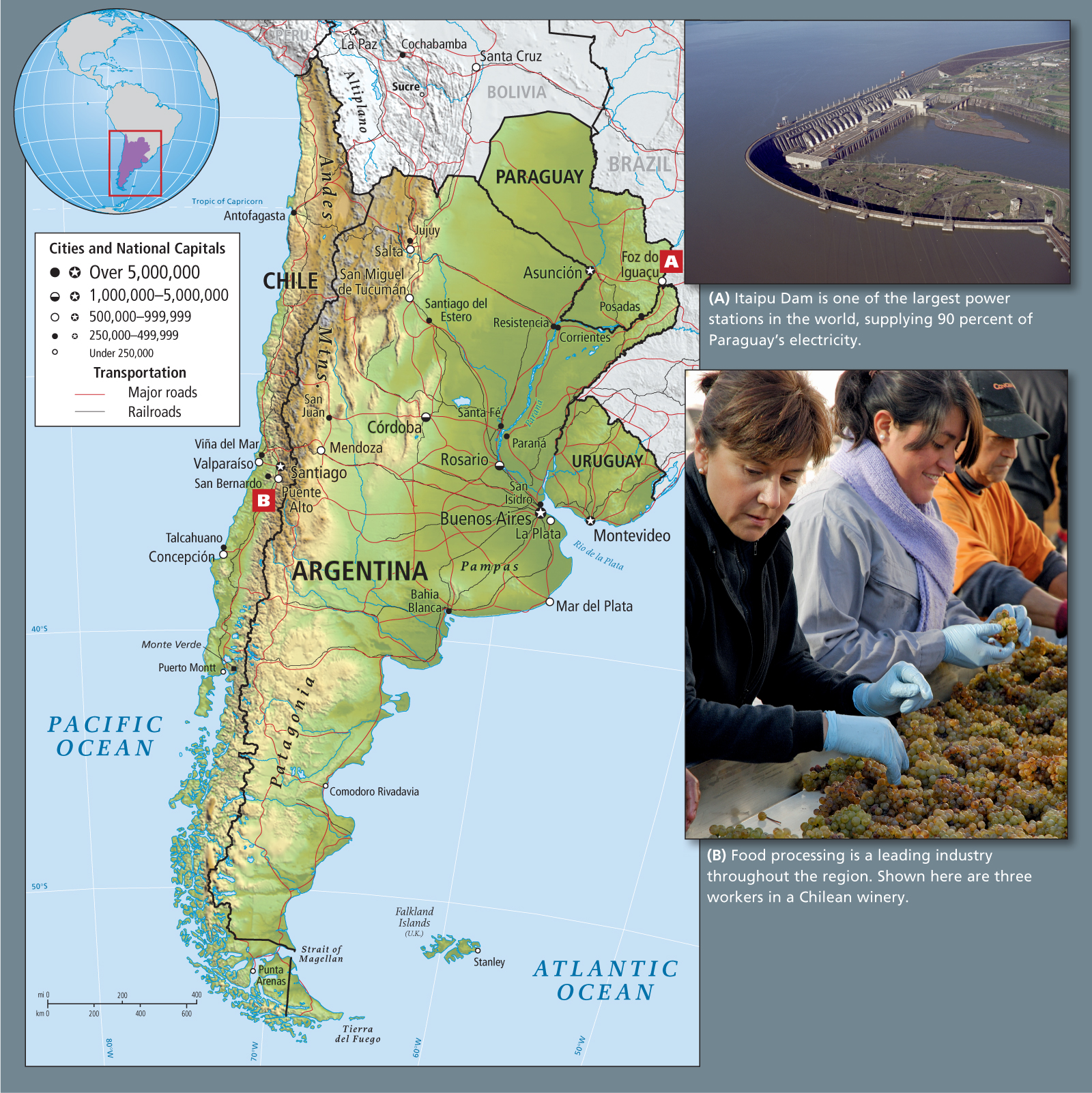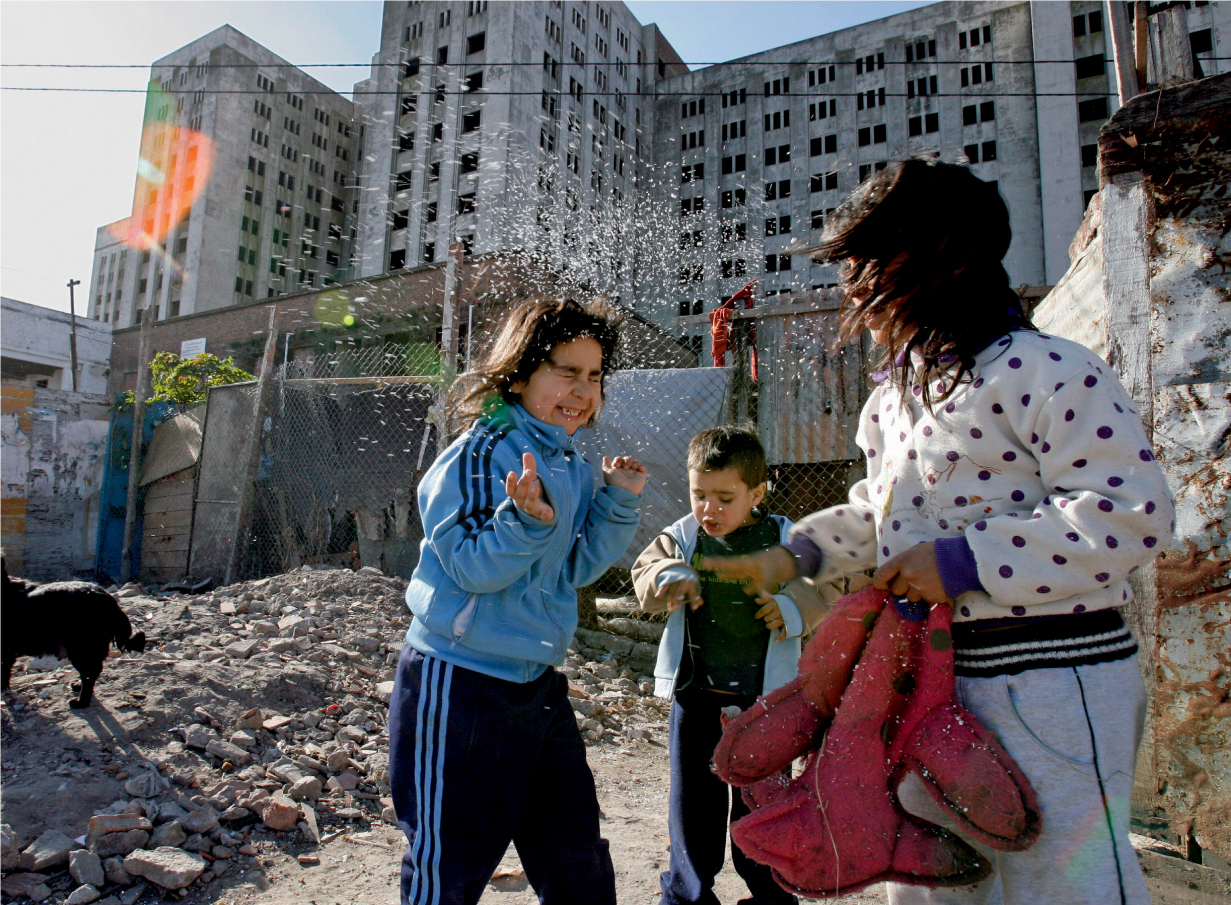The Southern Cone
The countries of Chile, Paraguay, Uruguay, and Argentina (Figure 3.37) have diverse physical environments but remarkably similar histories. The so-called southern cone of South America had little European settlement during the Spanish empire, but in the late nineteenth and early twentieth centuries, European immigrants—mainly Germans, Italians, and Irish—were drawn there by temperate climates, economic opportunities, and the prospect of landownership. These immigrants swamped the surviving indigenous populations throughout most of the region. Paraguay is the only one of these countries that has a predominantly mestizo population. It is the poorest country of the four (see Figure 3.22).

The Economies of the Southern Cone
Agriculture was once the leading economic sector in the southern cone, but it is no longer the main source of income or the main employer, having been replaced by the service sector. Nonetheless, agriculture remains prominent in the identity of the region and in its ability to earn foreign exchange through exports. The primary agricultural zone, the pampas, is an area of extensive grasslands and highly fertile soils in northern Argentina and Uruguay (and southern Brazil). The region is famous for its grain and cattle. Sheep raising dominates in Argentina’s drier, less fertile southern zone, Patagonia. On the Pacific side of the Andes, in Chile’s central zone, the Mediterranean climates of southern Argentina and Chile support large-scale fruit production that caters to the winter markets of the Northern Hemisphere. Both countries have greatly expanded wine production (see Figure 3.37B). Chile also benefits from considerable mineral wealth, especially copper.
 54. PRESERVING PUMALIN, MILLIONAIRES WITH A MISSION (CHILE)
54. PRESERVING PUMALIN, MILLIONAIRES WITH A MISSION (CHILE)
Although the agricultural and mineral exports of the southern cone created considerable wealth in the past, fluctuating prices for raw materials on the global market have periodically sent the economies of this subregion into a sudden downturn. The desire for economic stability was a major impetus for industrialization and urbanization in the mid-twentieth century. At first, the new industries were based on processing agricultural and mineral raw materials. Later, state policies supported diversification into import substitution industries. However, inefficiencies, corruption, low quality, and the small size of local markets prevented industry from becoming a leading sector for the region. Although the service sector has now surpassed agriculture and industry in the southern cone countries, it too is lackluster, providing only modest contributions to the GDP.
Economic policy has been a source of conflict within the subregion for decades. Despite their considerable resources, these countries have always had substantial impoverished populations that were nonetheless well-enough educated in European ways to demand attention to their grievances. In response, each country developed mechanisms for redistributing wealth—government subsidies for jobs, food, housing, basic health care, and transportation, for example—that did alleviate poverty to some degree, though they did not contribute to sustainable development or the spread of democratic institutions. When global prices for raw materials fell in the 1970s and produced an economic downturn with accompanying deprivation, people clamored for more fundamental changes. In response, throughout the 1970s and into the early 1980s, military leaders fearful of civil unrest and with the support of the elite, took control of governments (especially in Chile and Argentina) and waged bloody campaigns of repression against striking workers and the Socialist and Communist opposition. In the years of state-sanctioned violence that followed, known as the “dirty wars,” at least 3000 people were killed in Chile and 14,000 to 18,000 in Argentina, and tens of thousands more were jailed and tortured for their political beliefs (see page 154 for a discussion of the overthrow of President Salvador Allende in Chile in 1973). Laws that once granted blanket immunity to military officials involved in kidnappings, torture, and murder are now being rolled back in the quest for justice.
The IMF has consistently pressured governments to repay their massive debts, thereby shifting countries away from poverty-alleviation policies and toward free market economic reform. The effects of these policies in Chile have been mixed. Chile’s export-oriented industrial, mining, and agricultural sectors have all grown, but not sufficiently to alleviate the middle class social discontent that in 2006 led to the election of a moderate Socialist, Michelle Bachelet, as president. Bachelet chose moderate free market reforms, saving the profits from rich, government-owned copper mines to stimulate the economy during the recession of 2008. A more fiscally conservative president was elected and inaugurated shortly after the February 2010 earthquake.
Argentina, after suffering a long recession of its own, continuing job losses, and a crushing debt burden, defaulted on its debt payments in December 2001, causing a precipitous drop in foreign investment. An IMF package of structural reforms and loans to the Argentine government held off the crisis but did not resolve it. In 2006, Argentina, like Chile, elected a moderate socialist president, Néstor Kirchner, who increased government spending to quell social unrest, as has his wife, Cristina Fernández de Kirchner, who, after his death, was elected his successor. In 2012, Argentina’s debt was 45 percent of GDP, which is less than half of the U.S. debt or that of many countries in the debt-plagued European Union.
Climate Change and Social Stability
Argentina is suffering a protracted drought, the worst in 50 years. For this second-largest corn exporter behind the United States, the consequences have been devastating, including the loss of millions of cattle. As wheat and corn crops shrivel, hopes of coming through the global recession relatively unscathed are fading. Argentina is particularly afflicted because of its huge debt obligations (U.S.$2.2 billion due in 2012). In fact, top Argentine politicians fear that climate change may precipitate a coup d’état because farmers are so confrontational after being repeatedly hurt by drought and government agricultural policies. Other countries in the southern cone are also affected, as is southern Brazil, but Argentina’s financial situation leaves it in the most precarious position.
Buenos Aires: A Primate City
The primary urban center in the southern cone is Buenos Aires, the capital of Argentina and one of the world’s largest cities (Figure 3.38). Forty percent of the country’s people live in this primate city, which boasts premier shopping streets, elegant urban landscapes, and dozens of international banks. Yet six decades of decline have left it with environmental degradation, empty factories, social conflict, severe poverty, and declining human well-being (see Figure 3.38). Some people argue that the downward slide in quality of life in Buenos Aires is an unavoidable result of the restructuring required to create an economy that will be competitive in the global arena. Past Argentine leaders contended that greater integration with the global economy would help to reverse decades of malaise. They wanted Buenos Aires to be seen as a world city—a center with pools of skilled labor that attracted major investment capital, a sophisticated city with a beautiful skyline and a powerful sense of place. Although it is unlikely that present politicians have any lower ambitions for Buenos Aires, they have to deal with an impatient local population living in run-down apartments and on wages too low to afford basic nutrition. It is likely that the city’s poor residents wish to give priority to such basics as decent housing, better food, and modernized transportation—goals that will not necessarily draw profit-seeking free market investors.

THINGS TO REMEMBER
 The southern cone countries are environmentally diverse and have a fairly large immigrant population from Europe.
The southern cone countries are environmentally diverse and have a fairly large immigrant population from Europe. While the southern cone has relatively high GDP/HDI ratings, their economies are weakened by the struggle to pay off past debts, build more modern infrastructures, and meet the high expectations for living standards.
While the southern cone has relatively high GDP/HDI ratings, their economies are weakened by the struggle to pay off past debts, build more modern infrastructures, and meet the high expectations for living standards.